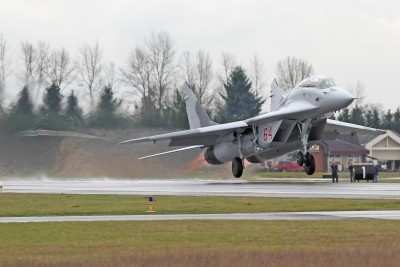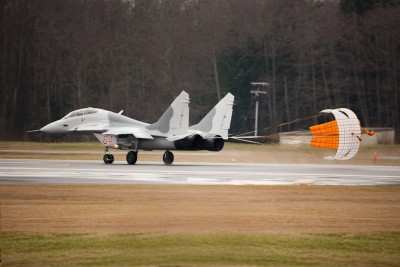Soviet-Era "Fulcrum" Restored By The Historic Flight
Foundation
A former Ukranian MiG-29 fighter has become the second privately
owned MiG-29 to fly, taking to the air over Washington
state six years after it left Eastern Europe. Capable of
speeds of Mach 2.2 and altitudes of nearly 60,000ft, the Mikoyan
Gurevich MiG-29 "Fulcrum" is a far cry from the 1927-57 vintage
airplanes that Historic Flight Foundation specializes in restoring.
However, the opportunity to work on something so different was an
irresistible lure to John Sessions, the founder of Historic Flight,
who wanted to verify that a complex high-performance aircraft could
be restored by following the same rules and guidelines as a vintage
airplane. The resulting aircraft is one of the most pristine
examples of it's type anywhere in the world.

Photo Courtesy Historic Flight Foundation
This two-seat MiG-29UB was manufactured in the Soviet Union
sometime between 1985 and 1991, and saw service with the 642nd IAP
(fighter air regiment) of the Ukrainian Air Force after the
collapse of the Soviet Union. During its service it racked up a
total of 510 flight hours. In the year 2000 the Ukraine began
retiring some of it's MiG-29s, and in 2005 this particular MiG-29UB
was demilitarized and offered for sale to the general public. The
Historic Flight Foundation heard about the sale through Tim Morgan
of Morgan Aircraft Restorations, and a deal was brokered to bring
the MiG-29UB to the US.
Because it is a front-line military fighter, the shipping
company hired to transport the aircraft to the United States split
it into two shipments to deter hijackers. The wing and engine
crates were shipped across the Atlantic while the fuselage was
loaded aboard a ship bound for the Pacific. At Hong Kong the
fuselage was off-loaded to change ships, but the shipper had
neglected to obtain a local import license. On April 4th 2006 it
was seized as military contraband. John Sessions immediately
traveled to Hong Kong in an effort to save the MiG. Two years and
many trips later, a Chinese judge ruled that the aircraft had been
properly demilitarized before arriving in Hong Kong and should be
returned to the Historic Flight Foundation.

(L-R) John Sessions, Doug Russell Photo Courtesy Historic
Flight Foundation
The fuselage finally joined the rest of the aircraft in the
Morgan Aircraft Restoration hangar at Arlington Municipal Airport
in 2008. Now the aircraft needed to be fully disassembled and all
parts inspected for damage, both from its previous service life as
well as the years spent in transit. Some parts that didn't make it
to the US would need to be fabricated from scratch, or duplicated
by making a mirror copy of a part on the other side of the
aircraft. Historic Flight Foundation is well known for its
meticulous restoration of vintage aircraft to "factory new"
condition, and the MiG-29 would be no exception. Any components
showing unusual wear or any sort of corrosion or damage were
replaced, including both huge RD-33 afterburning turbofan engines,
whose replacements had to be specially manufactured by the Klimov
factory in Russia.
While Historic Flight Foundation's MiG-29 lay in pieces in
Arlington there were two crashes of Russian Air Force MiG-29s just
a month apart. The investigation showed that the twin vertical
tails of the MiG-29 were prone to corrosion where they join the
fuselage, and that the two crashes were caused by the vertical tail
literally coming off in mid-air. The root cause was found to be a
combination of different metals used to attach the vertical tails
to the fuselage, which could react with one another and corrode
under the right conditions. It was decided that the only way to be
sure this wouldn't happen to Historic Flight's MiG-29UB would be to
redesign all of the attachment components entirely out of aluminum,
thus eliminating any other metals that might cause corrosion.

Photo Courtesy Historic Flight Foundation
Throughout the restoration process, experienced MiG-29 mechanics
were flown over from Slovakia to offer their expertise with an
aircraft that practically no western mechanics had ever worked on.
Their assistance proved to be invaluable, offering knowledge only
gained through decades of front line MiG-29 service.
The final restoration work to be done was cosmetic. Between
being retired and being sold the MiG had sat outside in the Ukraine
for years, suffering through many long winters. Then, during
shipment to the US, the fuselage was confiscated and spent another
two years sitting at a Hong Kong dock. Because of this, some of the
sheet metal on the aircraft had to be replaced, and the entire
plane also had to be stripped and repainted. The markings on the
aircraft were kept as close to original as possible, from the
pattern of the camouflage to the black panther on the nose.
The restoration was finally completed in December of 2010, but
there was still one critical component missing: the explosive
charges for the ejection seats. These charges were removed as part
of the demilitarization of the aircraft in the Ukraine, but
acquiring replacements and importing them into the US proved to be
quite a challenge. They were finally installed in January of 2011,
and the aircraft was ready to fly again.

Photo Courtesy Historic Flight Foundation
First flight of the newly christened N29UB occurred on January
23rd 2011, during which it was ferried from Arlington Municipal to
Snohomish County Airport in Everett, WA, the home of the Historic
Flight Foundation's vintage aircraft museum. The MiG-29UB is
scheduled to complete a 5-hour flight test program over the next
few days, gradually building up confidence in its systems. It will
reach altitudes of 60,000ft, speeds of Mach 0.97, and perform
high-g aerobatic maneuvers.
The Historic Flight Foundation plans to undertake the
restoration of two more MiG-29s over the coming years, which will
help finance their heritage activities.
 ANN's Daily Aero-Linx (04.13.24)
ANN's Daily Aero-Linx (04.13.24) ANN's Daily Aero-Term (04.13.24): Beyond Visual Line Of Sight (BVLOS)
ANN's Daily Aero-Term (04.13.24): Beyond Visual Line Of Sight (BVLOS) Airborne 04.09.24: SnF24!, Piper-DeltaHawk!, Fisher Update, Junkers
Airborne 04.09.24: SnF24!, Piper-DeltaHawk!, Fisher Update, Junkers Aero-News: Quote of the Day (04.14.24)
Aero-News: Quote of the Day (04.14.24) ANN's Daily Aero-Term (04.14.24): Maximum Authorized Altitude
ANN's Daily Aero-Term (04.14.24): Maximum Authorized Altitude






